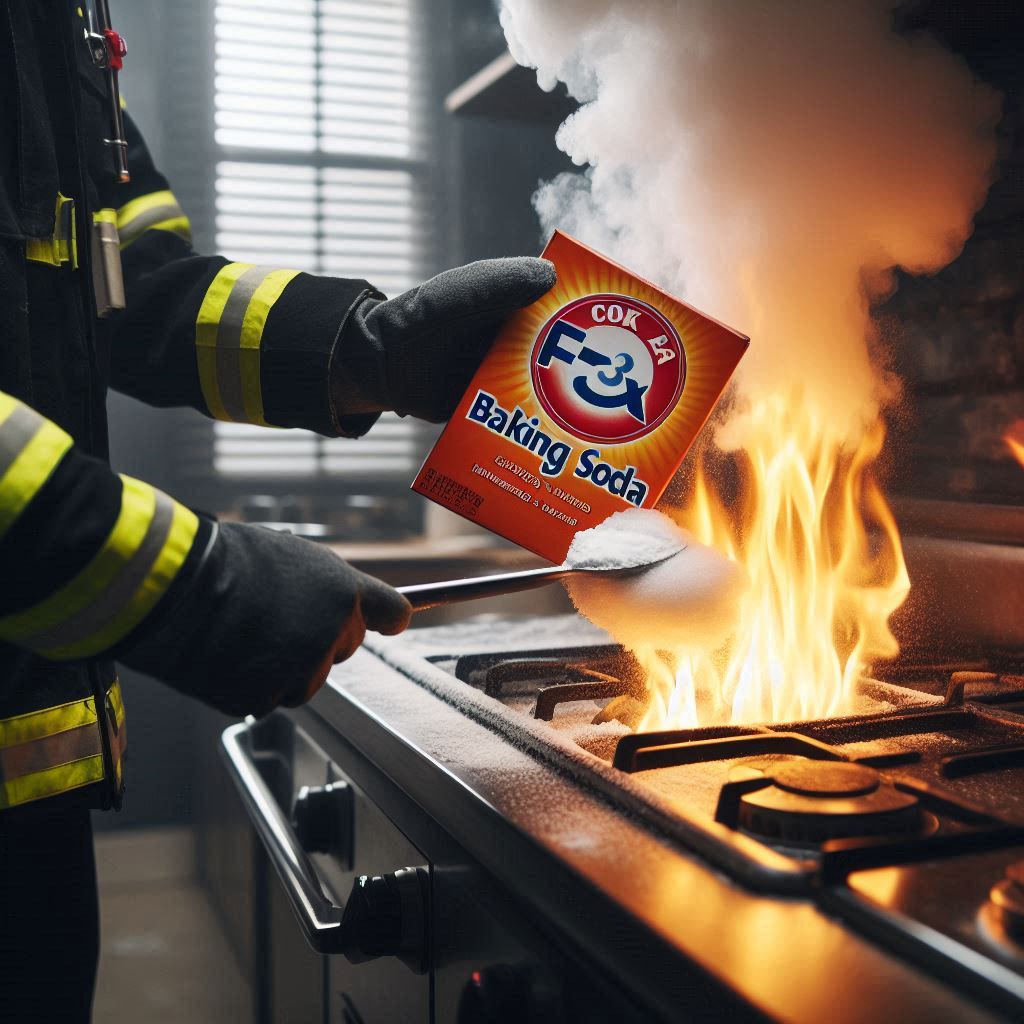
As a seasoned firefighter, I’ve been asked countless times if baking soda can truly extinguish a fire. Today, I’m here to provide you with a definitive answer backed by years of experience and expertise in the field. Many have debated the effectiveness of this household ingredient in combating flames, and I’m here to shed light on this burning question once and for all.
When it comes to fire safety, it’s crucial to separate fact from fiction. Baking soda has long been hailed as a versatile solution for various household tasks, but can it really stand up to the intensity of a fire? Join me as I delve into the science behind this age-old remedy and uncover the truth about its potential role in fire suppression. Let’s extinguish the myths and ignite our knowledge on whether baking soda can truly put out a fire.
Key Takeaways
- Baking soda works by releasing carbon dioxide gas when heated, which helps smother flames by displacing oxygen in small fires.
- Understanding the scientific principles behind using baking soda for firefighting is essential for maximizing its effectiveness.
- Baking soda can be highly effective in extinguishing small grease fires or electrical fires when applied correctly at the base of the flames.
- While baking soda may not be suitable for larger fires, it remains a valuable tool for quickly and safely extinguishing small fires.
- Real-life applications of baking soda include combating kitchen fires, electrical fires, outdoor grilling flare-ups, and garage workshop incidents.
- Proper storage and accessibility to baking soda can enhance preparedness in fire emergencies and aid in effectively tackling small fires before they escalate.
Exploring the Myth
When it comes to using baking soda to put out fires, there’s a lot of misinformation out there. As a firefighter with years of experience, I’ve encountered various myths surrounding this topic. Let’s delve into some of the most common misconceptions:
- Myth 1: Baking soda can extinguish all types of fires
- Myth 2: Baking soda is a universal fire extinguisher
- Myth 3: Baking soda is always the best solution in case of a fire
Exploring these myths is crucial in understanding the limitations and effectiveness of using baking soda as a fire suppression method. It’s essential to separate fact from fiction to ensure the safety of individuals and property in the event of a fire emergency.
In the next sections, we’ll dive deeper into the scientific principles behind using baking soda to combat fires and provide a comprehensive analysis based on real-world scenarios. Stay tuned to discover the truth about this age-old question and learn valuable insights into fire safety techniques.
Understanding the Science
When it comes to understanding how baking soda can put out fires, it’s essential to grasp the underlying scientific principles at play. Baking soda, also known as sodium bicarbonate, works by releasing carbon dioxide gas when heated. This gas helps to smother the flames by displacing oxygen, which is a key component necessary to sustain a fire.
In simpler terms, when baking soda is applied to a fire, it produces carbon dioxide bubbles, creating a barrier between the fuel source and oxygen in the air. Without sufficient oxygen, the fire loses its ability to burn and is eventually extinguished.
The chemical reaction between baking soda and heat that produces carbon dioxide is key to its fire suppression capabilities. It’s important to note that while baking soda is effective for smothering small grease fires or electrical fires, it may not be as effective for larger or more intense fires that require specialized extinguishing agents.
To maximize the effectiveness of baking soda in extinguishing fires, it’s crucial to remember a few key points:
- Aim for the base of the flames when applying baking soda.
- Use a sufficient amount of baking soda to create a thick barrier against oxygen.
- Be cautious and prioritize safety when attempting to put out a fire with baking soda.
Understanding the science behind how baking soda works as a fire extinguisher can empower individuals to make informed decisions during emergencies and effectively combat small fires in their surroundings.
Effectiveness of Baking Soda in Firefighting
Baking soda is a versatile household ingredient that can play a crucial role in firefighting. When it comes into contact with heat or flames, baking soda releases carbon dioxide gas rapidly, which helps smother the fire by displacing the oxygen fueling it. This chemical reaction is what makes baking soda an effective tool for extinguishing small fires quickly and efficiently.
In my experience as a firefighter, I have seen firsthand the effectiveness of baking soda in tackling small fires, especially those involving grease or electrical components. Its ability to rapidly release carbon dioxide and smother flames at the source can make a significant difference in containing and extinguishing fires before they escalate.
One important aspect to consider when using baking soda for firefighting is the need to apply it correctly. Ensuring that you aim at the base of the flames, where the source of the fire is located, can maximize its effectiveness. Additionally, using a sufficient amount of baking soda is essential to ensure that enough carbon dioxide is generated to smother the flames effectively.
Overall, while baking soda may not be suitable for larger fires due to its limited range and quantity, it remains a valuable tool for combating small fires efficiently. Its effectiveness lies in its ability to release carbon dioxide rapidly, depriving the fire of oxygen and helping to suppress flames effectively. Understanding how to properly utilize baking soda in firefighting situations can make a difference in quickly and safely extinguishing small fires.
Real-Life Applications
In real-life situations, baking soda serves as a reliable ally in combating small fires effectively. Whether it’s a kitchen mishap with a grease fire or an electrical malfunction, having baking soda on hand can be a game-changer. Here are a few scenarios where this household staple can make a significant difference:
- Kitchen Fires: Baking soda can swiftly smother grease fires when sprinkled generously over the flames. Its ability to release carbon dioxide helps starve the fire of oxygen, halting its spread.
- Electrical Fires: In cases of electrical fires, it’s essential to avoid using water due to the risk of electrocution. Baking soda provides a safe alternative, as it doesn’t conduct electricity and can be used to suffocate the fire without posing additional hazards.
- Outdoor Grilling: While enjoying a barbecue, flare-ups from fat drippings can sometimes escalate into small fires. Keeping a container of baking soda nearby can assist in quickly containing these flare-ups, ensuring a safe and enjoyable cooking experience.
- Garage Workshops: For individuals working with power tools or machinery in their garage, having baking soda within reach can be a smart safety measure. It can help address small fires that may occur due to tool malfunctions or electrical issues.
By understanding the practical applications of baking soda in fire emergencies, individuals can enhance their preparedness and response capabilities. Remember, proper storage and easy accessibility to baking soda can make a significant difference in swiftly and effectively tackling small fires before they escalate.
Conclusion
Baking soda emerges as a versatile and practical tool in fire safety, proving its efficacy in various fire scenarios. From kitchen mishaps to outdoor flare-ups, this household staple showcases its ability to swiftly extinguish flames and prevent escalation. As a firefighter, I recommend keeping baking soda within reach for quick and effective fire response. Its accessibility and effectiveness make it a valuable asset in enhancing preparedness and ensuring safety in the face of unexpected fires. Remember, a small box of baking soda can make a big difference in averting potential disasters. Stay safe and be proactive in fire prevention with this simple yet powerful ally.
Frequently Asked Questions
How can baking soda be used in fighting kitchen grease fires?
Baking soda can smother kitchen grease fires by releasing carbon dioxide gas, suppressing the oxygen that fuels the flames. Sprinkle it generously on the fire to extinguish it effectively.
Can baking soda help in combating electrical fires?
Yes, baking soda can be used to put out small electrical fires. It works by interrupting the chemical reaction of the fire, making it a safe and effective option in such emergencies.
How can baking soda be useful for outdoor grilling flare-ups?
For flare-ups during outdoor cooking, keeping a box of baking soda nearby can help smother the flames quickly and prevent the situation from escalating.
In what way can baking soda be beneficial in garage workshop incidents?
In garage workshop incidents involving small fires, having baking soda on hand can aid in swiftly extinguishing flames and preventing further damage. Its rapid suppression capabilities make it an essential firefighting tool in such situations.
